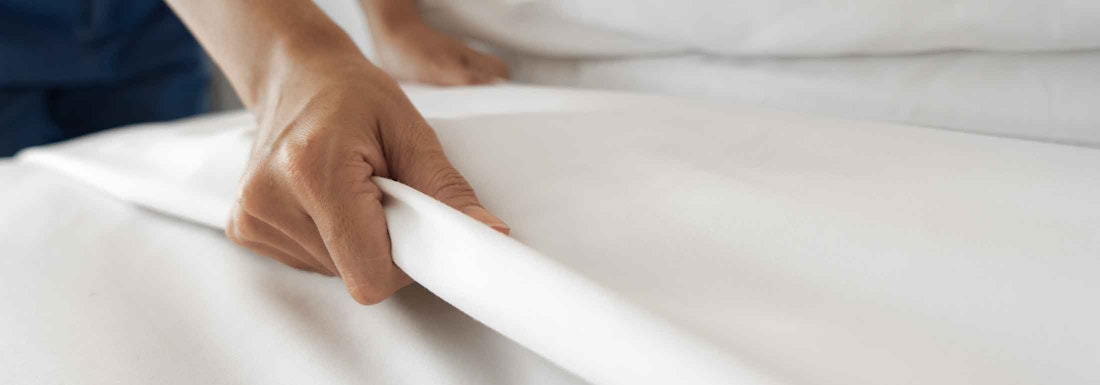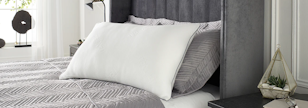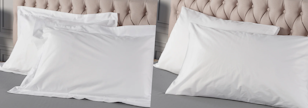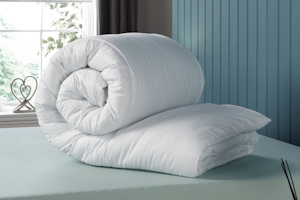30 Jun 2025

What is a Top Sheet and Should You Have One?
10 Jul 2023
A top sheet, also known as a flat sheet, is a piece of fabric that lies directly above you and beneath a comforter or duvet cover. The primary purpose of a top sheet is to keep your blanket or duvet cover clean for a longer period of time, as it serves as a barrier against dust mites, sweat, and bacteria that gather on the fabrics closest to your skin. This can make weekly laundering easier and provide a lighter layer for warm or hot weather, creating a cosy, layered feel.
However, as European duvet covers have gained popularity, the need for a top sheet has been called into question. Duvet covers now serve as the top bedding layer, protecting the infill and offering a smooth surface to sleep under. With this in mind, the choice of whether or not to use a top sheet may come down to personal preference and factors such as climate and the type of bedding you use.
Top Sheet Definition
A top sheet, also known as a flat sheet, is a piece of bedding that lies directly over you and underneath a comforter or blanket. It serves as a protective layer to keep your duvet cover or blanket clean for a longer period of time, as it prevents dust mites, sweat, and bacteria from gathering on the fabrics closest to your skin.
Traditionally, the primary purpose of a top sheet was to provide a smooth, easily washed layer between one's body and the tickly woolen blankets that were once more commonly used. However, as European duvet covers have become more popular than blankets, the duvet cover now serves as the top bedding layer that protects the infill.
Using a top sheet can offer a few notable benefits. For example, it makes weekly laundering easier, provides a lighter layer for warm or hot weather, and creates a cosy, layered feel in your bed.
In conclusion, a top sheet is a useful but optional addition to your bedding, providing protection and comfort depending on individual preferences and bedding habits.
Uses of a Top Sheet
A top sheet is an additional layer of bedding placed between the sleeper and their duvet or blanket. It serves various purposes which we will explore in this section.
Firstly, a top sheet acts as a barrier between your skin and the comforter, keeping the bed more hygienic. It helps to protect your comforter or duvet cover from dust mites, sweat, and bacteria that tend to accumulate on the fabrics closest to your skin. This subsequently allows your blanket or duvet cover to remain clean for a longer period, reducing the frequency of washing that bulky comforter.
Another use of a top sheet is to provide a lighter layer for warm or hot weather. When the temperature rises, you may find a duvet or blanket to be too warm, so having a top sheet allows you to be comfortable without feeling overheated. In this case, the top sheet can replace a comforter or blanket during the warmer seasons.
Additionally, top sheets contribute to a cosy, layered feel in your bed. They provide an added layer of protection for your comforter, which can be helpful if you have pets or young children. Moreover, using a top sheet can help to keep you cooler at night by allowing air to circulate between your body and the comforter, thus improving your sleep quality.
In summary, top sheets serve multiple purposes, from maintaining hygiene to providing extra comfort and protection. While they may not be essential for everyone, they certainly have their benefits and can improve your overall sleeping experience.
Types of Top Sheets
We must first understand what a top sheet is before discussing its various types. A top sheet, also known as a flat sheet, is a piece of linen that lies between you and your blanket or duvet cover. Its main purpose is to keep the blanket or duvet cover clean for longer by acting as a protective layer.
There are several types of top sheets available in the market, crafted from a range of materials and designs. We'll discuss some of the most common materials used for top sheets:
- Cotton: Cotton top sheets are probably the most common and popular choice due to their softness, breathability, and durability. They're available in various thread counts and can range from budget-friendly to luxurious options.
- Linen: Linen top sheets provide excellent breathability and have a unique texture that makes them an attractive option. They are known for being both durable and environmentally friendly, as they are made from flax plants.
- Silk: Silk top sheets offer a luxurious feel and are particularly suitable for those who want a more indulgent sleeping experience. They are beautifully smooth, naturally hypoallergenic, and can help regulate body temperature.
- Bamboo: Top sheets made from bamboo-based fabrics are an eco-friendly and sustainable choice. They are known for being soft, breathable, and moisture-wicking, making them ideal for hot sleepers or those with sensitive skin.
- Blended fabrics: Some top sheets are made with a blend of materials, such as cotton and polyester. These blends can combine the desirable qualities of both materials, such as the softness of cotton and the durability of polyester.
In summary, the primary types of top sheets available are made from cotton, linen, silk, bamboo, and blended fabrics. Each material offers its unique benefits, so it's essential to consider your personal preferences and needs when selecting a top sheet for your bed.
Pros and Cons of Using a Top Sheet
As we examine the topic of top sheets, it's essential to weigh the advantages and disadvantages of using them. A top sheet, also known as a flat sheet, is the bedding piece that goes between the sleeper and a duvet, comforter, or blanket. Top sheets are generally oversized compared to the size of your bed and do not include elastic edges.
Pros:
- Easier weekly laundering: Top sheets are considerably easier to wash and dry than comforters, duvets, or blankets. This makes refreshing your sleep surface a much simpler task.
- Lighter layer for warm or hot weather: A top sheet provides a lighter layer, essential for warmer weather or people who run hot during sleep. It also creates a comfortable, layered feel.
- Protection for your comforter or duvet: The top sheet acts as a barrier between your body and the comforter or duvet, helping to keep it clean for more extended periods. This can be especially useful if you have pets or young children sharing your bed.
Cons:
- Additional step in bed-making: Introducing a top sheet adds an extra layer to the bed-making process. It can be cumbersome for some and may mean more time spent making the bed each day.
- Annoying for restless sleepers: Some people may find that top sheets become tangled and twisted throughout the night, causing discomfort for restless sleepers.
- Technically unnecessary: While top sheets have their benefits, they are not strictly essential. Your comforter or duvet can still fulfil its purpose without the addition of a top sheet.
In summary, top sheets have benefits and drawbacks. It ultimately comes down to individual preferences and circumstances. You can decide whether or not a top sheet will be a valuable addition to your bedding based on your needs and preferences.
Factors to Consider When Buying a Top Sheet
When it comes to deciding whether or not to use a top sheet, there are several aspects to consider. In this section, we'll discuss a few key factors to keep in mind when choosing a top sheet for your bed.
Firstly, consider the climate and your personal sleeping preferences. Some people find using a top sheet adds a lighter layer, suitable for warm or hot weather, as it creates a cozy, layered feel without trapping too much heat. If you prefer extra insulation during colder nights, a top sheet can also be helpful in providing that additional layer.
Next, think about hygiene. A top sheet can protect your comforter or duvet cover from sweat, oil, dead skin cells, and dust mites. As a result, using a top sheet can help keep your heavier bed coverings cleaner for a longer period, reducing the frequency of washing them. Keep in mind that if you opt not to use a top sheet, you'll need to wash your duvet cover or comforter as often as your bed linens, ideally every two weeks.
Another factor to consider is aesthetics. Top sheets add a finished look to your bed and can contribute to the overall design of your bedroom. If you enjoy coordinating colours and patterns, a top sheet can be a fun addition to your bedding ensemble.
Finally, consider ease of laundering. Using a top sheet means there's an extra layer of fabric to wash and dry every week, which can be a downside for some people. On the other hand, it's often easier to launder a top sheet than a bulky comforter or duvet cover.
In summary, deciding whether or not to use a top sheet comes down to your personal preferences and priorities. If you value temperature regulation, hygiene, aesthetics, or laundry convenience, a top sheet could be a great addition to your bedding.
Alternatives to Top Sheets
We understand that some people may not prefer using a top sheet, which is perfectly fine as there are alternatives to consider. In this section, we will discuss a few of those alternatives that you can use in place of a top sheet.
One popular alternative to a top sheet is a duvet cover. A duvet cover is similar to a pillowcase for your comforter or duvet, providing a protective layer that can be easily removed and washed. If you choose to use a duvet cover instead of a top sheet, remember to wash it as often as you would change your sheets, or every two to four weeks if you're using a bottom sheet.
Another option is using a lightweight blanket in place of a top sheet. This can provide a similar level of protection for your comforter while still allowing air circulation. It is essential to choose a breathable fabric, such as cotton or linen, to ensure you stay cool and comfortable throughout the night. As with a duvet cover, wash your lightweight blanket regularly to keep your bedding fresh and clean.
For those who prefer a minimalist approach to bedding, using only a fitted sheet and a washable comforter is an option. With this approach, you can remove and wash the comforter as needed, eliminating the need for a top sheet or duvet cover. Keep in mind that not all comforters are machine washable, so be sure to check the care instructions before attempting to clean your comforter.
In summary, while top sheets have their benefits, they are not the only option for keeping your bedding clean and comfortable. Alternatives like duvet covers, lightweight blankets, and washable comforters can provide the same protection and comfort without the need for a separate top sheet.


